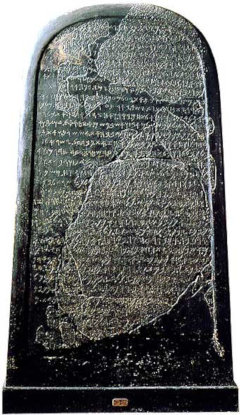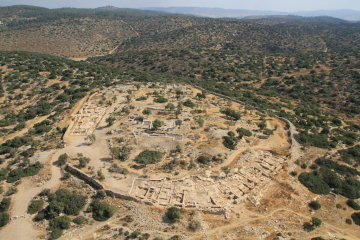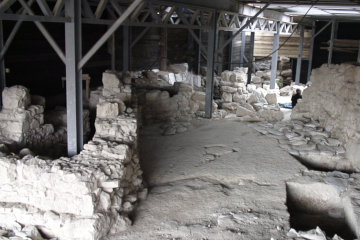Balak or David?

| |
| Frederick Augustus Klein in his clerical rather than his medical garb. |
The story of the Moabite Stone is a melancholy one. It was first discovered in 1868 when Frederick Augustus Klein, a German who had gone to Palestine as a medical missionary on behalf of the Anglican church's Church Missionary Society, stayed overnight in Dhiban in the course of his work. Klein was a dedicated believer who had gone to Palestine in 1851 and first settled in the Christian town of Nazareth, where his wife died that same year. He stayed there for another four years before transferring to Jerusalem, where he remained for twenty-two years before returning to Germany and settling down to translate Christian literature into Arabic.
Because of his facility with the language, as well as his medical skills, Klein was welcomed by the wild Beduin tribes of Trans-Jordan and, by some accounts, he was the only Westerner who could move safely and unescorted in that area. In 1868 Frederick Klein had occasion to travel from Jerusalem to Kerak, a journey that would take two or even three days on horseback.

| |
| A flock of sheep near Dibhan. Although the beduin are now settled, they still keep animals. |
On August 19, 1868, Klein arrived in Dhiban and was offered hospitality by the sheikh of a nearby encampment of Bani Hamida beduin. Somehow the talk around the campfire turned to the antikas for which Westerners had an insatiable and inexplicable longing and someone mentioned the nearby ruins where a stone lay on which was some sort of writing. Klein expressed his interest and in the morning, accompanied by his new friends, he went to see it. He could not read the writing but he did recognise that it was an exceptional find and offered the tribesmen £80 sterling for it.
Unfortunately Klein, as a poor missionary, did not have £80, so on his return he went to his friend, the Prussian Consul, and urged him to purchase the stone. The consul sent a message to the Berlin Museum and they immediately telegraphed authorisation for the expenditure. Unfortunately the message was not in code and the telegraph operators were loquacious; by nightfall the news of the impending German purchase was all over Jerusalem.
There are different versions on what happened next. We know that other groups, such as the Palestine Exploration Fund, high-mindedly refrained from interfering in the affair, recognising the prior claim of Klein and his German friends. One story has it that the news of German government involvement reached the Bani Hamida, who promptly raised the price. Exactly how and why the news travelled from the sophisticated townies of Jerusalem to the despised wandering tribesmen of Trans-Jordan is not explained, which makes me a little dubious about this version.

| |
| Charles Simon Clermont-Ganneau, the villain of the Moabite Stone story. |
A more likely story, in my opinion, revolves around Charles Simon Clermont-Ganneau, a Frenchman who held the post of dragoman to the French Consulate in Jerusalem. Relationships between the French and the Germans were severely strained at this time - in fact, in 1870 the two countries were to go to war in the Franco-Prussian War which saw the French emperor defeated at Sedan and taken prisoner, Paris besieged and captured, and a humiliating peace treaty imposed by the victors.
Clermont-Ganneau became aware of the German offer for the stone and decided to acquire it for France. His opportunity came when a neighbouring sheikh to the man in Dhiban refused to allow the stone to be transported through his territory - this, of course, was just a ploy to get his fingers into the pot of Frankish gold. While negotiations were underway with this other sheikh Clermont-Ganneau sent his own emissary to Dhiban. A local Arab, named Yakub Karavaka (spellings vary), was authorised to offer £375 and part of the deal was that Karavaka be allowed to make a "squeeze" of the stone. (It is possible that Clermont-Ganneau had no real interest in obtaining the stone but hoped that publication of the squeeze would steal the German thunder.)
In the days before silicon rubber, a squeeze was the best way of obtaining an exact replica of something. You laid a sheet of wet paper over the object and dabbed it with the end of a stiff brush, forcing the paper into every crevice and cranny of the object. You repeated the process with other layers of wet paper until you had built up a reasonable thickness, then you allowed the paper to dry and carefully lifted it off.
Karavaka did as instructed with the wet paper, but while he and his two companions stood around waiting for the paper to dry in the hot sun a quarrel broke out among the watching Beduin. The exact reason for this quarrel is unknown but somehow or other weapons became involved and Karavaka was stabbed in the leg by a spear. Not unnaturally Karavaka decided that his presence was urgently required in Jerusalem and leaped on his horse. One of his companions followed suit but the other, with tremendous presence of mind, ripped the still damp squeeze off the stone. Unfortunately, because it was still wet, it stuck to the stone and the first attempt only tore off part of the squeeze. The man had a second go and tore off another strip, and then a third go, and by the time he was on his horse he had seven strips of soggy paper - and the long, jolting ride down to the Dead Sea and up the other side to Jerusalem did not improve the quality of the squeeze.
There was now a pause in affairs: Clermont-Ganneau had spoiled the Prussians' scholarly coup and the consul was not sure whether there was any point in pursuing the matter. And, of course, both parties were distracted by the build-up to the Franco-Prussian War, which began in July 1870. Again there are two versions of what happened next.
One story is that the Prussian Consul, unwilling to be blackmailed by all the sheikhs between Dhiban and Jerusalem appealed to the Turkish authorities who, already at loggerheads with the Bani Hamida, were happy to oblige. The Bani Hamida, unwilling to see the stone fall into the hands of their mortal enemies and - suspecting that the money they had been offered would end up in Turkish hands rather than their own - destroyed the stone.
The other is that the Bani Hamida, impressed by the huge leap from £80 to £375, had been putting their collective mind to the problem of why the infidels should be so keen to have the stone and had reached the conclusion that the answer must be that the stone was, in fact, hollow and stuffed with gold. (Aristotelian logic was never a strong point among the followers of the Arabian prophet.) The involvement of the Turks merely confirmed this conclusion. They therefore lit a large fire on top of the stone and when the stone was red-hot hurled buckets of cold water over it, shattering it into several large pieces and innumerable fragments.
When, to their astonishment and chagrin, no gold was revealed the next obvious conclusion was that the stone was a powerful talisman or medicine. Exactly what this medicine was good for was not known with any certainty, but all the tribesmen eagerly claimed a piece of the stone, some to bury it in their fields to keep pests and disease away, others to bury it in the thatch of their barn roofs to keep disease and the evil eye away from the cattle, while yet others sewed it into pouches and wore them round their necks - and no doubt felt ever so much better in consequence.

| |
| The Moabite Stone today; the light-coloured fragments are set in a darker cast made from Karavaka's squeeze. |
As soon as news of the stone's destruction reached Jerusalem the Prussian Consul lost all interest in the affair - but there was considerable indignation against Clermont-Ganneau, whose unprincipled interference had led, more or less directly, to the loss of the stone. He felt sufficiently guilty that he spent the next couple of years sending out agents to hunt down any pieces of the stone that could be found and purchasing them. In all, it cost him 32,000 francs and in the end only 60% of the stone was recovered; Clermont-Ganneau and his agents recovered 38 pieces and an unnamed Englishman obtained another 18 small pieces, which he rather generously donated to the French. A final piece was obtained by a German scholar, who also donated it to the French.
Fortunately the whole of the text could be reconstructed from the squeeze and Clermont-Ganneau undertook the first translation while the stone fragments were still at the French embassy in Jerusalem. In 1872 he announced that he had discovered the name "David" - "Daoud" - in the text. Unfortunately the sorry state of the squeeze means that some of the readings are disputed - and "David" is one of them!
Which brings us to another melancholy tale, that of the Israeli archaeologist Israel Finkelstein. He has been teaching at various universities in Israel and abroad since 1976 and over the years developed an extreme scepticism regarding the Biblical record of Israelite history. In part this was because he dated the Exodus to the time of Rameses II and could find no archaeological evidence in either Egypt or Palestine to support the Exodus story; in part it was because of the extreme paucity of remains in Jerusalem, where nothing from the time of David and Solomon had been found.
As a result, in his lectures and his writings, he argued that David and Solomon were little more than village chieftans. The fabled temple of Solomon probably never existed and his wealth and wisdom were all fairy tales based on the later importance and position of the Jewish kingdoms. Although extreme, these were not unreasonable conclusions - based upon what was then known. Unfortunately, Mr Finkelstein had never fully accepted the trite but true saying that "absence of evidence is not evidence of absence"!
Over the years a succession of discoveries have tended to disprove his claims. The most dramatic was in July 1993 when Gila Cook, one of the workers on the team of Avraham Biran at the excavations of Tel Dan in northern Israel, discovered fragments of a stone stele that appears to have been erected by the Syrian king Hazael. In the text the author boasts of his destruction of the "house of David" - and minor village chieftans do not leave such a mark on history that a century and a half later their country is still known by their name!

| |
| The recently excavated site of Khirbet Qeiyafa, above the Elah Valley |
In 2007 Yosef Garfinkel began excavations at a site that had been known about for years but considered of no importance - Khirbet Qeiyafa. Pottery discovered in the course of excavations pointed to Iron Age IIa, a conclusion confirmed by radio-carbon dating of two burned olive stones. On their basis Garfinkel dates the site to 1050-970 BC and if we accept the earlier date, the fortress may well have been built by Saul, the first king of Israel.
The construction of an Israelite fortress in such a provocative position on the very border of Philistine territory would be adequate explanation for the confrontation between the Israelites and the Philistines accompanied by their redoubtable champion, Goliath of nearby Gath! The strength of the Israelite position on top of the steep slope leading up to Khirbet Qeiyafa would explain why the Philistines were in no hurry to attack, but tried to provoke the Israelites to come down into the valley by Goliath's taunts. The need to keep the Philistines at bay while they raised the walls of the fortress would explain why the Israelite army stayed in the field, content to maintain a watching brief. The arrival of impetuous young David must have been a considerable aggravation to King Saul, just when everything was going nicely!
Even more interesting, however, was the discovery of ostraca that pointed to Qeiyafa as an administrative centre where taxes could be gathered. The language used on the otraca was almost identical to Biblical Hebrew. Garfinkel states that his discoveries support the idea "that the kingdom of Judah existed already as a centrally organised state in the tenth century BC."
Naturally Finkelstein has reacted furiously, though his arguments range from the petty to the downright ridiculous. For example, he argues that the carbon-14 dates should be rejected on the basis that nearby Philistine fortresses are younger; it doesn't seem to have occurred to him that these other sites may have been built by the Philistines as a response to the construction of Qeiyafa!
Further support against Finkelstein's position has come from excavations to the south of the Temple Mount/Haram in Jerusalem. Substantial Iron Age structures have been uncovered that may very well be the remains of palaces and administrative buildings. A couple of seals or seal-impressions have been found which bear the names of individuals mentioned in the Bible as associated with the royal court.
Most interesting of all, in the light of the Tel Dan inscription, is the suggestion made in 1994 by Andre Lemaire - and widely accepted since then - that not only does the name "Daoud" appear on the Moabite Stone, but that the entire phrase should read "Beth Daoud" - "House of David". Here is the relevant passage:
"... I built Beth-Medeba and Beth-diblathaim and Beth-Baal-Meon and transported thereto the shepherds ... and the herders of the flocks of the land. And at Horonaim dwelt there the House of David. And Chemosh said to me, "Go down, make war upon Horonaim". I went down and made war ... and Chemosh dwelt in it during my days. I went up from thence ..."

| |
| The letters in dispute have been carefully overwritten by the white lines and arrows. The reader may form his own conclusions as to the motivation for this. |
Finkelstein's latest attempt to bolster his failing theory is rather clever; he has turned to the venerable Moabite Stone, re-examined the "House of David" and claims that the name should, in fact, be "Balak". Balak, in case you have forgotten your Biblical history, was the Moabite king who employed the renegade prophet Balaam to come and curse Israel. Finkelstein must be hoping that both Jews and Christians will be so delighted to have "proof" that Balak existed that they will overlook the destruction of testimony to the "House of David"!
It is true that the two words, "Beth Daoud" occur across the break between a fragment of stone and a reconstruction from the squeeze - that, after all, is why the words were such a puzzle for so long a time. However Finkelstein's suggestion is just plain daft.
It is also true that Hebrew, particularly hand-carved ancient Hebrew, is not the clearest of scripts (and Moabite is just a variation on ancient Hebrew). I suppose it is possible that a "B" might be a carelessly written "D". In the same way, a final "K" is very little different to the letter "D" and with a bit of imagination a "W" might be mistaken for an "L" - but that all three letters should have been written so carelessly does strain credulity a bit.
Credulity is even more strained, however, by the thought that while Hazael of Syria could not have remembered the "House of David" after a mere century and a half (as Finkelstein and others have claimed), a hitherto unknown "House of Balak" may have existed in Moab for five and a half centuries! Even worse, that this hypothetical "House of Balak" may have remained a thorn in the sides of the Moabite kings as a separate ruling dynasty until Chemosh sends Mesha against it. And, of course, is it likely that Mesha's triumphant boasts of how he conquered the hated Jews should be interrupted mid-flow to include reference to a civil war that can only have weakened his Moabite kingdom?
It's no wonder that Finkelstein, anxious to preserve his scholarly reputation, is quick to hedge his claims. He admits that he cannot be certain about his new reading. "At the end of the day," he says, "the reconstruction of the name 'Balak' is circumstantial."
=============
no archaeological evidence The lack of evidence for an Exodus under Rameses is hardly surprising. To take a similar example, there is a total lack of evidence for Drake's round the world voyage in the time of King George V and an equally complete lack of evidence for men landing on the moon during the reign of Elizabeth I! Bible chronology places the Exodus nearly two hundred years before the reign of Rameses II and if Egyptian chronology requires revision, that figure could be even higher. Return

| |
| Scaffolding holding up the Arab houses above the excavations on Mt Ophel. |
paucity of remains The Ophel Ridge, which all scholars agree is the site of the City of David, is thickly inhabited by Arab houses and quite apart from a natural aversion to having their backyards turned into archaeological sites, the inhabitants also have a doctrinaire dislike of contributing in any way to verifying Jewish history in Jerusalem. In recent years the Israelis have bulldozed their way through - or rather, under - these objections by digging beneath the Arab houses, leaving them perched rather insecurely on blocks of earth held up by scaffolding poles. Whatever the legality of these operations, the result has been the discovery of significant remains from the time of David and Solomon. Return
© Kendall K. Down 2019





